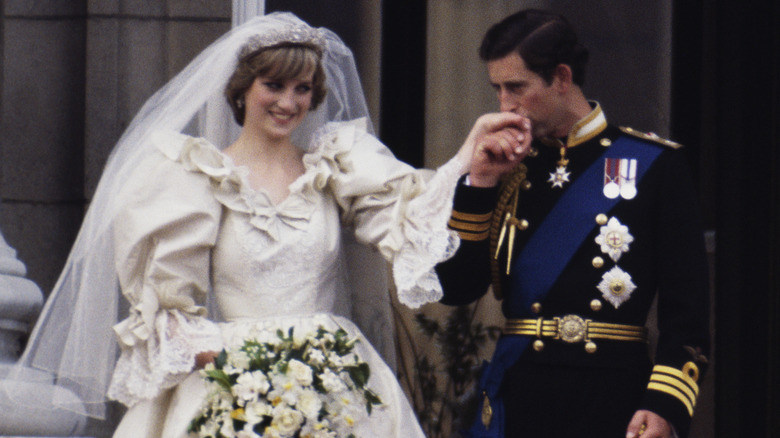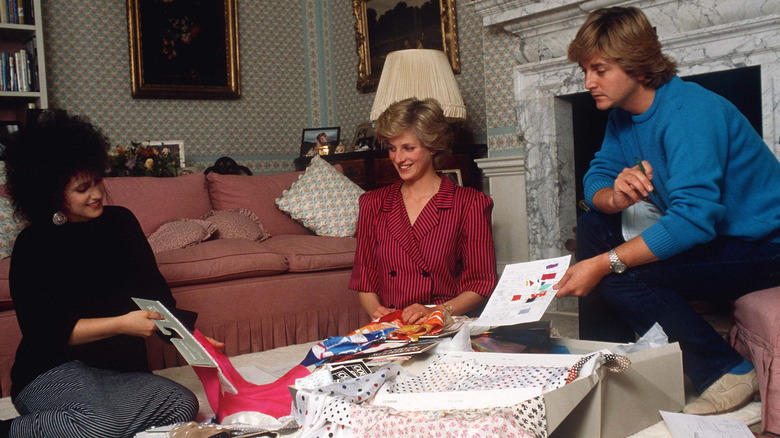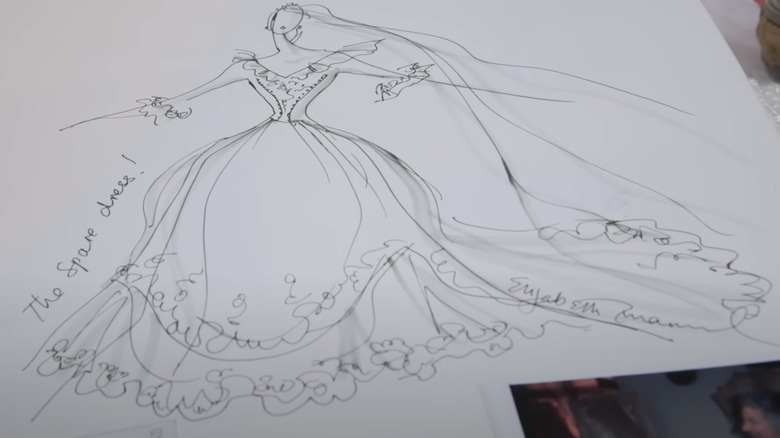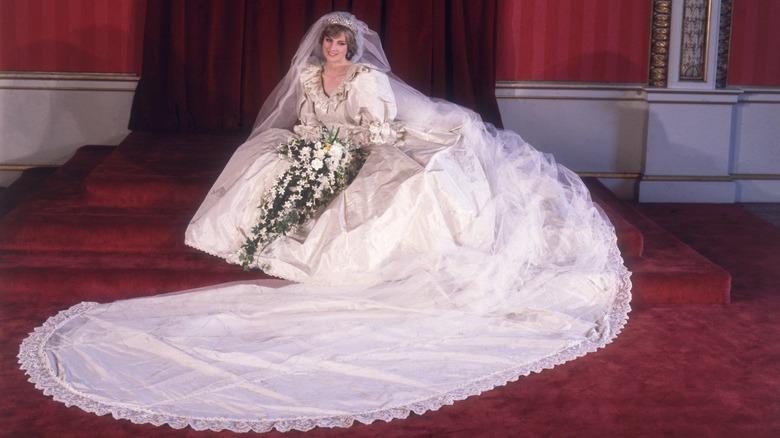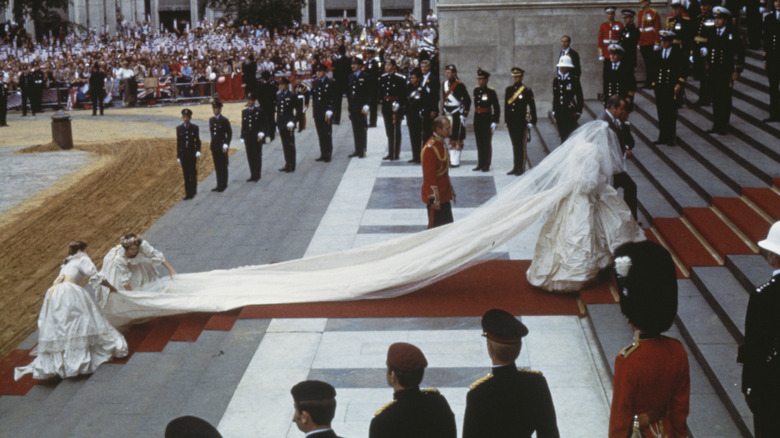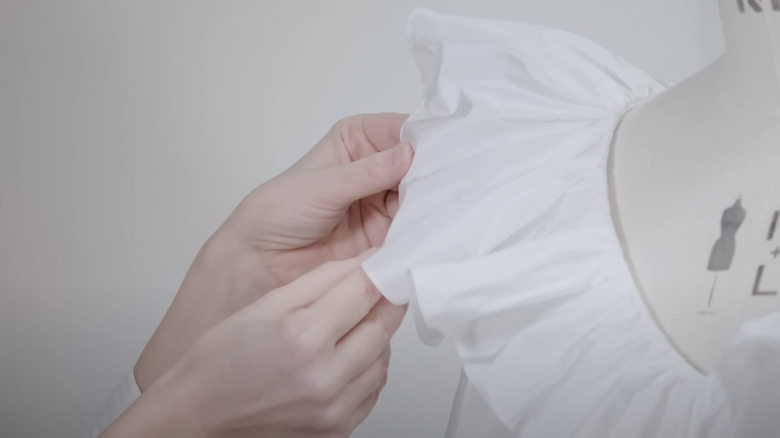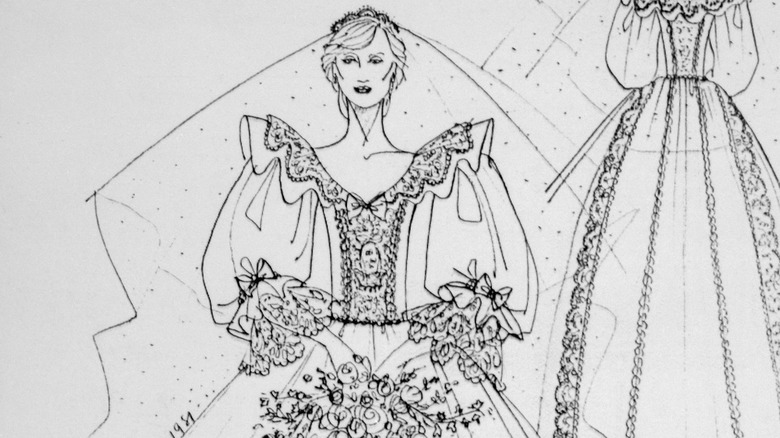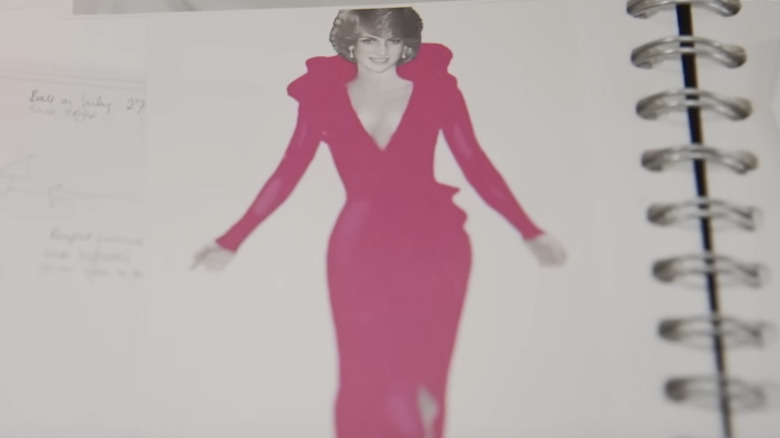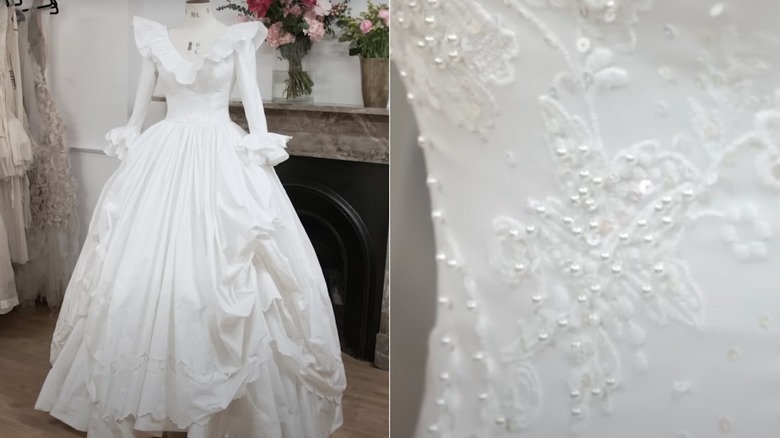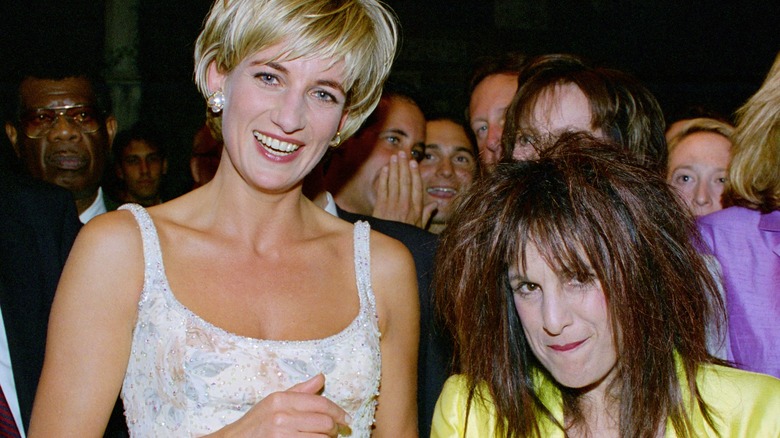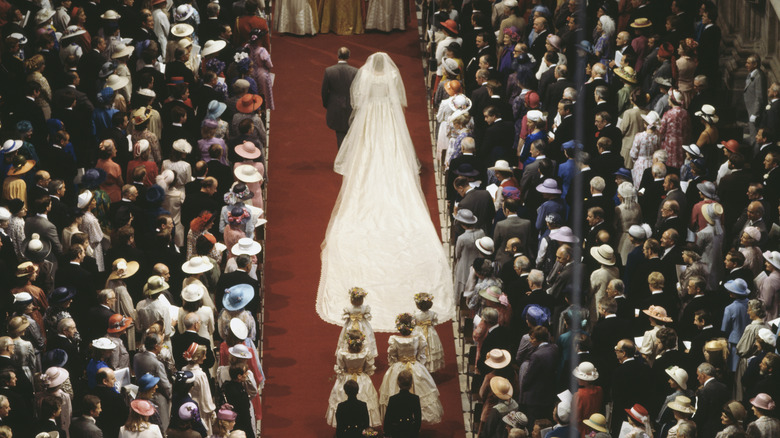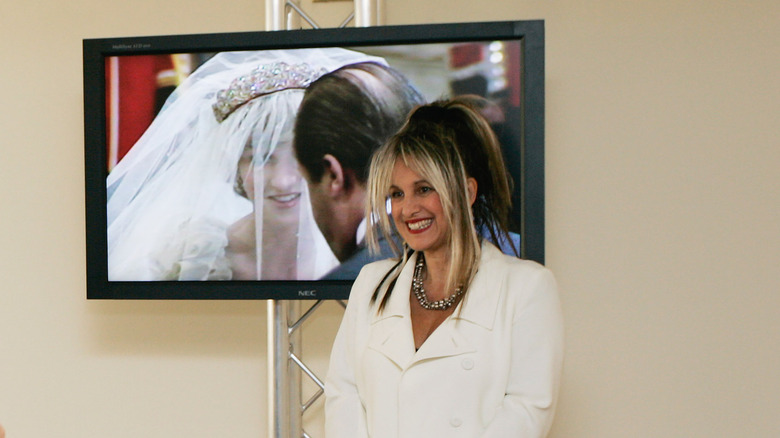All The Details About Princess Diana's Backup Wedding Dress
It was the wedding heard 'round the world. On the bright summer morning of July 29, 1981, King Charles III (then Prince Charles) wed Lady Diana Spencer, who became the Princess of Wales following her nuptials. It was an imperial era for the royal family, with over 750 million viewers from over 70 different countries tuning in to the televised broadcast of the wedding.
All eyes were on the opulence of St. Paul's Cathedral and the busy London streets lined with guards and well-wishers, not to mention the gold-encrusted carriage that transported the 20-year-old bride. However, no piece of the puzzle garnered as much attention as Diana's wedding gown. Symbolizing excess, high fashion, and royal tradition all in one, the dress featured antique lace, elaborate embroidery, and a seemingly never-ending train. Almost instantly, it became one of the most iconic dresses of the 20th century.
What royal fans might not know, though, is that there was a second dress waiting in the wings the entire time. While we never got to see this backup dress in action, co-designer Elizabeth Emanuel has since come out to discuss the design process behind crafting this gown and how it differed from the legendary ivory number that actually made it down the aisle that day in 1981. In honor of the impact Princess Diana made in fashion history, let's take a look at some of the most surprising features of this dress that "never was," as Elizabeth has dubbed it.
It was designed by a former fashion duo
Between figuring out how to find the right size to choosing your vibe — bohemian? romantic? traditional? — selecting a wedding dress is no easy feat, much less for a famous bride. Luckily for Princess Diana, she had not one but two highly skilled British designers by her side when she was constructing her wedding gown. Elizabeth and David Emanuel ran the Emanuel Salon where they created custom ensembles for the who's who of the '80s, including Cher and repeat wedding dress-wearer Elizabeth Taylor.
With those resumes, it's no surprise that the princess chose the power couple to create her era-defining gown. However, much like Diana and Charles bitterly parted ways, the fashion duo also divorced in the '90s. They've since been embroiled in a series of public feuds. For years, the exes have fought over who actually owns the right to claim themselves as the creator of Princess Diana's wedding gown. Most troubling of all, it was announced in 2021 that David was suing his ex-wife for auctioning off some early sketches of gowns — including the famous wedding gown — that the couple had designed for Princess Diana.
Interestingly, though, the wedding gown Diana wore wasn't the only wedding gown they'd designed for her. Although she didn't know it at the time, Diana would end up with two gowns for the big day. Rather than outsourcing the creation of a backup dress to less prestigious designers, Elizabeth and David took it upon themselves to design Princess Diana's secret second gown.
Princess Diana never knew it existed
Normally, a bride-to-be is heavily involved in every aspect of her wedding dress-tailoring process. While she may not actually be the one sitting down at the sewing machine, she is at least working behind the scenes with her team of stylists, bridesmaids, and family to ensure that everything looks perfect for her big day. However, when your wedding is not just a personal affair but a matter of international news, you might be forced to relinquish a bit of control.
In fact, in Princess Diana's case, she never even knew that her dress designers, Elizabeth and David Emanuel, were secretly constructing an entirely new, second wedding dress. While some might view this as an act of betrayal on the Emanuels' part, Elizabeth has since come out to argue that their secret-keeping was actually an act of kindness.
In 2024, Elizabeth sat down with People to regale them with exclusive details about this elusive second gown. She admitted that its construction was "a complete secret" but went on to explain that they did this to avoid worrying the princess. Considering Diana's rocky relationship with the press at the time, she was almost certainly experiencing high levels of stress in the days leading up to her wedding. With that said, perhaps the Emanuels can be forgiven for keeping their bride in the dark regarding gown No. 2.
It was created out of fear of an accident or burglary
Princess Diana was the most photographed woman across the globe. Though that title might carry connotations of privilege, the reality of Diana's life was that there were almost always countless risks to her person every time she stepped outside of the house. Just look at the way she was eventually taken from us — killed in a car accident in a Paris tunnel after being chased down by paparazzi. And the pursuit for pictures began before wedding bells had even rung.
Before she married then-Prince Charles, the soon-to-be princess was the subject of tabloid fodder, with paps and journalists alike eager for any snap or scrap of a story they could find relating to Charles' fiancée. It was this frenzied nature that Elizabeth Emanuel credits as being the impetus for the creation of a backup wedding gown.
Speaking with People, Elizabeth said, "I was a bit neurotic, and I thought, 'What happens if somebody breaks in and steals the dress or something spills or there's a fire or it gets stolen?' " While it might sound far-fetched, an obsessive fan or saboteur breaking into the Emanuel Salon was a real fear. In 2020, Elizabeth recalled to Vogue how Buckingham Palace offered "no protection" against the press. Paparazzi were glued to the pavement outside her and David's showroom in the days leading up to the ceremony.
It was missing the most iconic element: the train
One of the most knockout features of Princess Diana's wedding dress was its record-breaking train. The concept of a wedding dress train dates back to the Middle Ages, and yet Diana's 1981 gown was still marked down in the history books as a first. This is because it was the longest-recorded train in royal history, cascading down the front steps of St. Paul's Cathedral to an impressive 25 feet. Nevertheless, this unforgettable fashion moment would not have happened had she needed to wear her backup gown. The spare dress featured no train, not even a short one.
With its laced edge and the look of an ivory sea, there's no denying that the gown's 25-foot train is an integral part of what made Princess Diana's wedding day such an important moment in cultural history. It may sound like an odd decision to refuse to replicate this important feature in case of an accident or emergency, but time and space were factors. "This other dress [was] not exactly like the royal wedding dress because to try and recreate that would have just taken too long, and we were a tiny little studio [and] ... we were very busy," Elizabeth explained to People.
The backup gown was bright white instead of ivory
White or ivory? Eggshell or snow? The color white comes in a variety of shades. While you may not remember this conundrum causing any problems in your elementary art classroom, choosing the right shade of white can be a big decision for a bride who is planning her wedding day.
However, for someone like Princess Diana, whose legendary wedding was so much larger than a family affair, just one shade of white was out of the question. Thanks to designers Elizabeth and David Emanuel, the British royal had two wedding gowns of two different hues. In the end, it was the ivory silk taffeta dress that made it down the aisle with the young bride. Yet, waiting in the wings back at the Emanuel Salon was an entirely different gown dyed a shade of pure white. "We used to put bits of fabric [in] lots of different colors in the bins just to throw the journalists off the scent," Elizabeth admitted to People.
While the backup dress was also constructed of silk, it would have made for a very different aesthetic had it been called upon that July morning in 1981. Dressed in her ivory gown littered with antique lace, Princess Diana's final look made sure that her ceremony unfolded like a scene from a bygone era, presenting an atmosphere of timeless romance. In another universe, though, her second gown in a crisp white color would have signaled a wedding that was waving goodbye to the old ways and representing a new, modern page for the royal institution.
It was also missing the long, puffy 1980s sleeves
When you think of 1980s fashion, what are the first features that come to mind? Leg warmers? Shoulder pads? Acid wash everything? Many of these '80s fashions have been making a big comeback, but it seems that one of the most iconic closet staples of the '80s has been left to the history books: puffy sleeves. Princess Diana was the cover girl of the puffy sleeves. And due to the iconic frou-frou style sleeves of her wedding gown, she officially cemented her reputation as one of the "it" girls of the time. But unbeknownst to the future royal, dressmakers Elizabeth and David Emanuel secretly crafted a backup dress that not only lacked a train but also puffy sleeves.
While it featured ruffles along the neckline and the cuffs somewhat similar to the gown No. 1, this second dress sported fitted long sleeves that would have clung tight to Diana's arms, cutting an altogether new silhouette. It wasn't just the trendy bubble-like shape these new sleeves were lacking, though. They were also completely crisp and clean — absent of the high-end lace that the Emanuels had supplied by Roger Watson Laces. Without puffy sleeves, Diana's backup dress would have turned her into a completely different kind of bride — no longer maximalist and heirloom-adorned but one of understated elegance.
It was inspired by one of Princess Diana's pre-wedding gowns
From bridal showers to rehearsal dinners, it's not uncommon for a bride-to-be to enjoy a series of pre-wedding parties ahead of her big day. Princess Diana was no different. In the days leading up to her nuptials, the 20-year-old attended a wedding ball held at Buckingham Palace. It was there that some got their first taste of Elizabeth and David Emanuel's designs.
Instead of dressing the future Princess of Wales in something prim and proper, a sultry hot pink number was the ticket. Years later, Elizabeth opened up about the design process and how this forgotten frock was actually the main inspiration behind Princess Diana's backup wedding gown. Speaking to Hello! magazine, Elizabeth recalled how Diana asked her to design "a very sexy dress to shock everyone."
The result was a bright raspberry-colored gown cut into a mermaid style. It also included three-quarter-length sleeves with ruffles on the cuffs — just like her backup dress! There's no denying that this dress, with its figure-hugging skirt and low V-neck, would have surely shaken up any blueblood who had been invited to Buckingham Palace that night. Elizabeth confirmed to People that Diana's backup wedding gown was based on the pink gown she and David had designed for the princess. Unlike the original dress, though, it featured a ball gown-style skirt comprising 45 feet of fabric.
It was recreated in 2024
For decades, Princess Diana's backup wedding dress was an unknown footnote in the story of her famed wedding ceremony. While the vision was alive and well in the memory of co-designer Elizabeth Emanuel, the frock was never seen by Princess Diana nor the adoring public. Sadly, it's unknown what happened to it. "It likely ended up on some sample rail. It probably got reused, torn up, thrown out, who knows?" Elizabeth told People.
However, thanks to archived materials such as old sketches and clips from a documentary, the former partner of the Emanuel Salon was able to put her skills and memory to the test to recreate this long-lost piece of sartorial history. The recreation was completed and shared with the public in 2024. Still, there are some differences between the original construction of the dress and the modern reconstruction.
The first difference is that this gown was a solo invention, created by Elizabeth Emanuel long after she split from her husband and longtime collaborator, David Emanuel. The second, and most crucial, difference is that this rendition of the gown is complete. While the original backup gown would have worked in a pinch, it turns out that the Emanuels never fully completed the gown, considering it was only on standby for emergencies.
The recreation was sold to a virtual museum
Recreating Princess Diana's backup wedding dress may have been a personal project for co-designer Elizabeth Emanuel, but that doesn't mean it was created solely for personal purposes. While the dressmaking process forced Elizabeth to revisit old sketches, measurements, and memories, the recreation was immediately sold and shipped off from the fashion designer's studio after it was completed.
Who was the mysterious buyer? Instead of being scooped up by a multimillionaire art collector, the dress was purchased by The Princess Diana Museum. This is a unique museum experience that doesn't have a brick-and-mortar location but rather takes place completely online. While this means that visitors won't be able to view the ruffles and threads of the dress in person, it does mean that everyone the world over will be able to view this interesting piece of history from the comfort of their own homes.
The virtual museum was founded by Australian super fan of the royal Renae Plant, who also serves as the museum's director and curator. For Plant, this iconic piece of Princess Diana's history is just the latest acquisition to join her large portfolio of Diana-related fashion, including pieces from designers such as Catherine Walker and Versace. While the museum founder was proud to share the news of her latest buy, she declined to share the price. Speaking to People magazine, Plant said, "You cannot put a price tag on history."
It very well could've made it down the aisle
While Elizabeth Emanuel has coined this backup dress to be "the dress that never was," another insider who was present on the day of the nuptials claims that dress No. 2 almost did make it down the aisle after all.
Barbara Daly, who applied the Princess of Wales' makeup on the day of her headline-making wedding, told People about an incident that occurred just before the ceremony. Luckily for Daly, the culprit wasn't makeup — it was Diana's perfume, Quelques Fleurs.
According to Daly, Diana was dabbing some drops of the scent on the inside of her wrists when she accidentally fumbled the bottle and spilled some of the perfume onto the taffeta skirt of her dress. While the accident did leave a stain, it wasn't too noticeable enough to make the Emanuels reach for the backup dress. Instead, Daly said she advised Diana to cover up the spot with her hand as she walked, which she did. While this incident was only a blip on the radar, it could've changed royal history as we know it.
It wasn't the only secret backup element the Emanuels created
With the steady stream of attention Elizabeth Emanuel's recreation of the backup dress has gotten, you might think that this ruffled number is an extreme rarity. However, it isn't the only item of its nature in the Emanuels' back catalog. In addition to the backup dress, the then-married couple also crafted a backup parasol for Princess Diana to use if the moment arose.
A parasol is an umbrella that is usually smaller and more decorative than your usual stormy weather accessory. Often used at outdoor weddings to shield the bride from either rain or sun, these objects serve just as much of an aesthetic purpose as they do a functional purpose. Princess Diana's parasol was no exception. Rough drafts in the Emanuels' sketchbook detailed how it was to be created: "Made of the same fabric as wedding shoes and trimmed with lace, hand embroidered with sequins and pearls."
It was a smart decision from two prepared designers, as the weather predictions for July 29, 1981, called for overcast skies with the chance of light showers. Princess Diana would have surely cut a romantic and whimsical figure carrying her pearl-adorned parasol through the mists of London rain. However, Elizabeth later admitted to the Daily Mail that the parasol she and David created was "made of such light material that it certainly wasn't waterproof — it wouldn't have done her much good!"
